Crochet for Children

Crochet
for Children
Get your little ones hooked
on crochet with these 35 simple projects
 Claire Montgomerie
Claire Montgomerie
Published in 2011 by CICO Books
an imprint of Ryland Peters & Small Ltd
2021 Jockeys Fields, London WC1R 4BW www.cicobooks.com 10 9 8 7 6 5 4 3 2 1 Text copyright Claire Montgomerie 2011
Design and photography copyright CICO
Books 2011 The authors moral rights have been asserted. All rights reserved. No part of this publication may be reproduced, stored in a retrieval system, or transmitted in any form or by any means, electronic, mechanical, photocopying, or otherwise, without the prior permission of the publisher. A CIP catalogue record for this book is available from the British Library. eISBN: 978 1 782492 82 5
ISBN: 978 1 907563 80 5 Printed in China Editor: Kate Haxell
Design: Emma and Tom Forge
Photography: Martin Norris
Additional photography: Emma Mitchell
Styling: Sophie Martell
 Contents
Contents
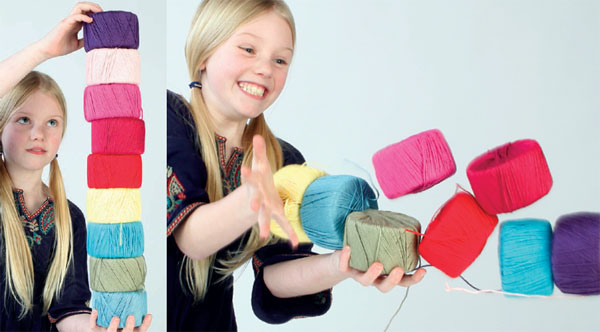
Crochet is a craft that is often considered the poor cousin of knitting and so often is I think wrongly forgotten or dismissed as old-fashioned or not relevant. However, crochet stitches are much easier to work in the round and in three-dimensions than knitting, which makes it the perfect craft for toy-making, and so I think is a great skill for children to pick up.
Aside from this, there are many other practical reasons to learn to crochet, especially as a child. It is a fun pastime, but it could also be beneficial to childrens development. Crocheting involves a lot of counting and simple maths, as well as being relaxing and therapeutic, which means that it can aid learning and concentration in some children, especially in those with learning difficulties or attention disorders. The main problem is that there are far fewer crochet books than those that champion knitting, and it is even harder to find a crochet book that caters for children. It is imperative that a child has a book aimed at their age group as, through teaching many groups of both adults and children how to crochet and knit, I have discovered that the methods needed to teach both groups are very different. It is important that, while a child-friendly book should not be too complicated, it should also not be too simple or babyish.
The projects must be interesting enough to hold a childs interest, as their concentration span can be very short, though they can most definitely cope with more challenging patterns. Bearing this in mind, I have aimed to write an interesting, informative and fun book, with lots of simple yet alluringly colourful patterns, which are both exciting and easy to make. I also wanted the projects to be modern and fresh, to prove that crochet is most definitely not an old-fashioned craft and have even used the traditional, and often derided, granny square in new and interesting ways. I believe that anyone can learn to crochet; all it takes is lots of practice and perseverance, which we know not all children want to do. However, the projects in this book are so small, simple and repetitive that I hope they will want to move onto the next, and will not even realize that they are progressing through the techniques. The toys mainly use similar techniques in a basic body, with non-crocheted embellishment.
So that once a child is used to the technique involved, they can choose the shape they like and finish their toy with felt, fabric, beads and buttons in whichever way they wish to create their own unique creatures and animals, encouraging individuality and creativity. 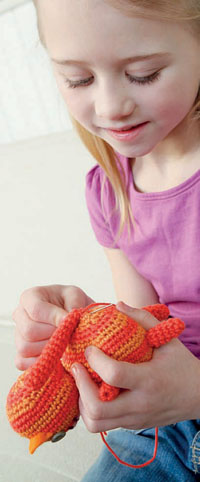 With the yarn, I have tried to choose compositions that are easy to use and often formulated especially for children, utilizing a mix of natural fibres to ensure they are kind to young, sensitive skin, and manmade fibres to make them durable and easy to wash and care for. However, I have also suggested alternatives so you and your child can play with the look of the projects and use remnants of yarns that are to hand, as many of the patterns use very small amounts of yarn. People mistakenly often think that crochet projects can only use crochet cotton. The trouble with this material is that is can be hard and very fine, which is not conducive to a fun and quick-to-work project, so I have introduced lots of wools and other fibres as well, which should be kind to your childs hands and be easy to hold. Before you dive into the patterns, please do take the time to read my tips on teaching your child to crochet (see ), as I hope my hints and tricks will help make the experience enjoyable and ensure the memory is a warm and happy one for all involved.
With the yarn, I have tried to choose compositions that are easy to use and often formulated especially for children, utilizing a mix of natural fibres to ensure they are kind to young, sensitive skin, and manmade fibres to make them durable and easy to wash and care for. However, I have also suggested alternatives so you and your child can play with the look of the projects and use remnants of yarns that are to hand, as many of the patterns use very small amounts of yarn. People mistakenly often think that crochet projects can only use crochet cotton. The trouble with this material is that is can be hard and very fine, which is not conducive to a fun and quick-to-work project, so I have introduced lots of wools and other fibres as well, which should be kind to your childs hands and be easy to hold. Before you dive into the patterns, please do take the time to read my tips on teaching your child to crochet (see ), as I hope my hints and tricks will help make the experience enjoyable and ensure the memory is a warm and happy one for all involved.
Most importantly of all, dont forget to have fun! Claire Montgomerie While teaching all kinds of craft workshops for children, I have developed a few priceless and failsafe practices that should ensure that crochet will become a fun hobby for any young child. Even if you do not follow them all rigidly, I recommend you stick at least to the simple tools and materials and have a play with the techniques and tips to find out what your child enjoys crocheting. 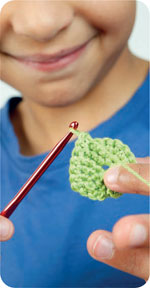 Your first question is probably, what is the best age to begin teaching your child how to crochet? The truth is, there is no perfect age, as it depends on the individual. It is possible to learn the very basics as young as four or five, if your child has highly developed motor skills and is used to doing arts and crafts with you. However, I have found that the best age is seven or eight, as by this time most children are dexterous enough, have good hand-eye coordination and can concentrate for longer periods of time. They will also be more likely to take all the techniques in and adopt crochet as a hobby and skill that they never forget.
Your first question is probably, what is the best age to begin teaching your child how to crochet? The truth is, there is no perfect age, as it depends on the individual. It is possible to learn the very basics as young as four or five, if your child has highly developed motor skills and is used to doing arts and crafts with you. However, I have found that the best age is seven or eight, as by this time most children are dexterous enough, have good hand-eye coordination and can concentrate for longer periods of time. They will also be more likely to take all the techniques in and adopt crochet as a hobby and skill that they never forget.
Crochet can be fiddly to learn, due to the need to hold the yarn correctly, so to gauge whether you think your child may be ready to learn, the best thing to do is to teach them to create long lengths of chain. The basic crochet stitches can be quite tricky to master at first and are nearly impossible if you have not first perfected the trick of holding the yarn to create an even tension. The good news is that once the tension is mastered, the stitches can be picked up very quickly, as each stitch builds upon the last. So encourage your child to practice getting the perfect tension by making long lengths of basic chain until you feel that they are ready to move onto the stitches. The chains can easily be made into necklaces or friendship bracelets so that your child doesnt feel as though making them is a fruitless activity. When choosing tools and materials, there are a few pointers to follow to make them more desirable to young fingers.

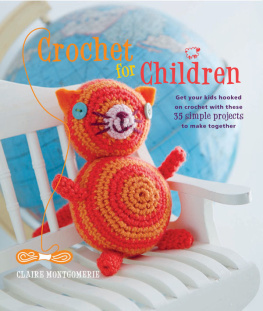
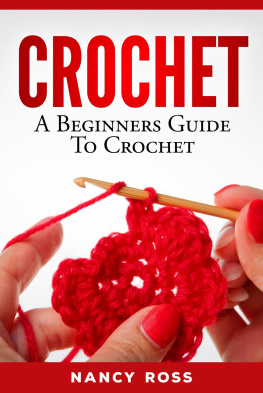

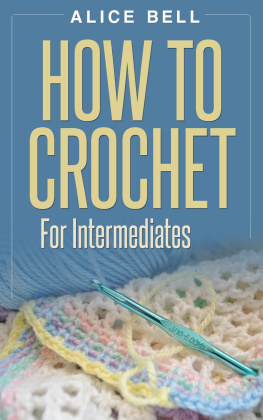
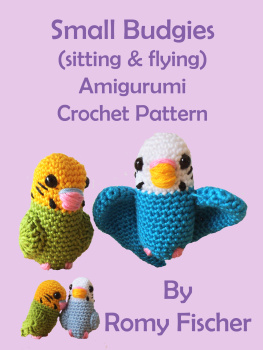
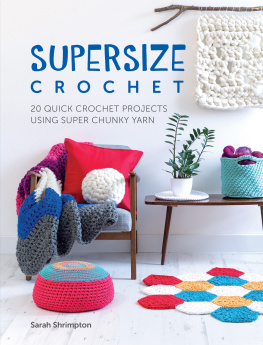
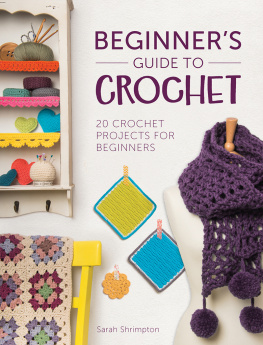
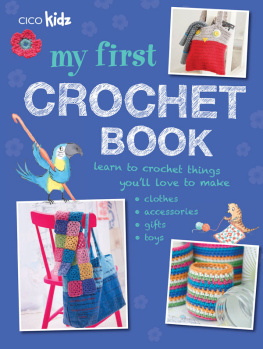

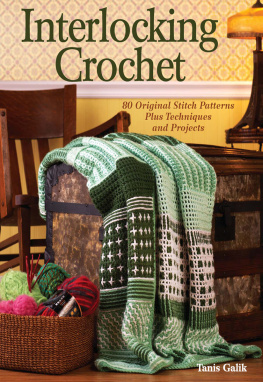


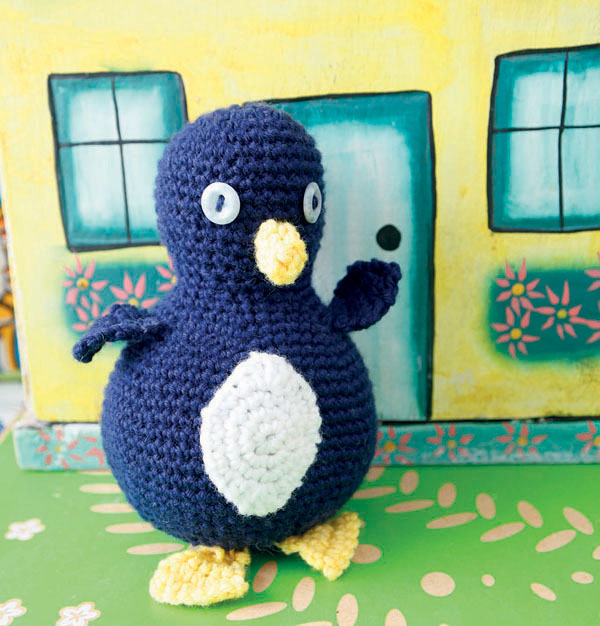
 Claire Montgomerie
Claire Montgomerie Published in 2011 by CICO Books
Published in 2011 by CICO Books Contents
Contents
 Crochet is a craft that is often considered the poor cousin of knitting and so often is I think wrongly forgotten or dismissed as old-fashioned or not relevant. However, crochet stitches are much easier to work in the round and in three-dimensions than knitting, which makes it the perfect craft for toy-making, and so I think is a great skill for children to pick up.
Crochet is a craft that is often considered the poor cousin of knitting and so often is I think wrongly forgotten or dismissed as old-fashioned or not relevant. However, crochet stitches are much easier to work in the round and in three-dimensions than knitting, which makes it the perfect craft for toy-making, and so I think is a great skill for children to pick up.  With the yarn, I have tried to choose compositions that are easy to use and often formulated especially for children, utilizing a mix of natural fibres to ensure they are kind to young, sensitive skin, and manmade fibres to make them durable and easy to wash and care for. However, I have also suggested alternatives so you and your child can play with the look of the projects and use remnants of yarns that are to hand, as many of the patterns use very small amounts of yarn. People mistakenly often think that crochet projects can only use crochet cotton. The trouble with this material is that is can be hard and very fine, which is not conducive to a fun and quick-to-work project, so I have introduced lots of wools and other fibres as well, which should be kind to your childs hands and be easy to hold. Before you dive into the patterns, please do take the time to read my tips on teaching your child to crochet (see ), as I hope my hints and tricks will help make the experience enjoyable and ensure the memory is a warm and happy one for all involved.
With the yarn, I have tried to choose compositions that are easy to use and often formulated especially for children, utilizing a mix of natural fibres to ensure they are kind to young, sensitive skin, and manmade fibres to make them durable and easy to wash and care for. However, I have also suggested alternatives so you and your child can play with the look of the projects and use remnants of yarns that are to hand, as many of the patterns use very small amounts of yarn. People mistakenly often think that crochet projects can only use crochet cotton. The trouble with this material is that is can be hard and very fine, which is not conducive to a fun and quick-to-work project, so I have introduced lots of wools and other fibres as well, which should be kind to your childs hands and be easy to hold. Before you dive into the patterns, please do take the time to read my tips on teaching your child to crochet (see ), as I hope my hints and tricks will help make the experience enjoyable and ensure the memory is a warm and happy one for all involved. Your first question is probably, what is the best age to begin teaching your child how to crochet? The truth is, there is no perfect age, as it depends on the individual. It is possible to learn the very basics as young as four or five, if your child has highly developed motor skills and is used to doing arts and crafts with you. However, I have found that the best age is seven or eight, as by this time most children are dexterous enough, have good hand-eye coordination and can concentrate for longer periods of time. They will also be more likely to take all the techniques in and adopt crochet as a hobby and skill that they never forget.
Your first question is probably, what is the best age to begin teaching your child how to crochet? The truth is, there is no perfect age, as it depends on the individual. It is possible to learn the very basics as young as four or five, if your child has highly developed motor skills and is used to doing arts and crafts with you. However, I have found that the best age is seven or eight, as by this time most children are dexterous enough, have good hand-eye coordination and can concentrate for longer periods of time. They will also be more likely to take all the techniques in and adopt crochet as a hobby and skill that they never forget.